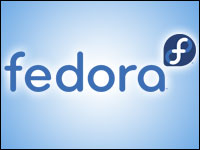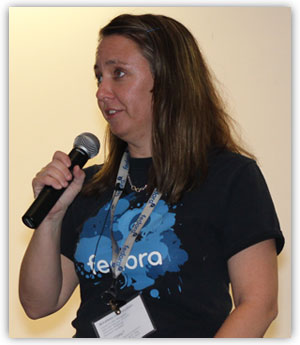
The Fedora Project is perhaps one of the hallmark Linux distributions. Fedora is sponsored by Red Hat, the commercial developer of Red Hat Enterprise Linux (RHEL). Red Hat’s investment in the Fedora community is collaborative. As such, Fedora Linux releases often provide RHEL developers with a field test environment that incubates innovative open source software technologies.
Red Hat Linux 1.0 was released in late 1994 as Red Hat Commercial Linux. It was the first Linux distribution to use the RPM Package Manager as its packaging format. The distribution spawned several other distributions, such as CentOS, Mandriva Linux and Yellow Dog Linux. Red Hat discontinued the Red Hat Linux distro in 2004, replacing it with Red Hat Enterprise Linux to meet the targeted needs of enterprise environments.

The Fedora community continues to develop its own Fedora distro as a non-commercial (free) version for consumers who elect not to pay for enterprise support. Its development is guided by what community leaders call its core values, or the Four Foundations — freedom, features, friends and first.
This foundation asserts that use and distribution of Fedora should be free and supported by a worldwide community of friendly users. The goals include creating new technical features to advance the effectiveness of Fedora Linux, which are released before other distros through a biannual schedule.
In this interview LinuxInsider discusses with Fedora Project Leader Robyn Bergeron the pressing issues impacting the growth of Fedora Linux, and how it is steering the progress of the FOSS (Free Open Source Software) movement.
LinuxInsider: How do you see open source software faring in today’s enterprise market?
Robyn Bergeron: Open source in general, along with the enterprise market, continues to fare very well. If you asked me 10 years ago, I’d think it was an area that showed some interest. At this point it has become a business of some US$8 billion, and is a model that has proven itself. I don’t see that slowing down any time soon. That’s not because a lot of people see it as a way of saving money in their operations.
LI: Do you see IT people sharing that assessment about open source?
Bergeron: It’s really the power of community projects getting a lot more testing. They get a lot more security reviews than traditional commercial products. There are a number of reasons why open source has gotten good enough and has proven itself as a business model. More and more IT managers are aware of the benefits of open source. It’s been an outreach and then proving that it really does work. We are really at that point now with open source.
LI: Given your glowing review of open source, why aren’t we seeing more widespread adoption of the Linux desktop, especially in business settings?
Bergeron: I think there are a couple of different reasons. In the enterprise server market there are pieces of that industry rooted in Microsoft Windows, and that goes back for a long, long time. Certainly people making the jump from Unix to Linux in the server market was not that big of a deal.
With regards to the desktop market, though, going back to the days when I was an analyst covering the desktop stuff, Windows has had a major stronghold there for as long as I can remember. While Mac’s OS-X has certainly made some headway here, I think part of that is the experience of owning the Mac product and opening the box and seeing how pretty it is all the way through it.
LI: So you are saying the product market is ignoring the Linux desktop foothold?
Bergeron: That desktop product experience ties in with owning your iPod and your iPhone and other iThings that you have. You know, companies like Adobe make stuff for the market, and the bulk of the market is still with Macintosh and Microsoft. The Linux desktop market still has a pretty small fraction of a percent there.
When a company wants to make a piece of software, doing it on more than one platform certainly adds to the engineering time and things like that. I think for a long time the Linux experience on the desktop was just different. A lot of times, people do not like to do things that are just different. Particularly if they are not a technical person and just need to get their job done, they are not necessarily interested in this new technical thing. Things like iTunes don’t really work in Linux. I don’t know if there is ever going to be a focus on that.
LI: Then how do you move the product market towards the Linux OS?
Bergeron: The interesting thing is that a lot of software vendors are not necessarily targeting a particular kind of market or a particular platform. The idea of having the software in a service model or just pushing a lot of applications into the clouds may actually turn out better for the Linux desktop. After all, it is a heck of a lot cheaper to have a Linux desktop than it is to buy Windows licenses.
I think the whole ecosystem has to move along with it. People really are becoming more comfortable doing applications in the cloud. Still, some people are holding on to the old notion that terrible things can happen to your data in the clouds. I think it is just a matter of time. In the next five years things will look vastly different. That can have a big impact on what people are using for their desktops at work.
LI: Looking at that prospect as we move toward the future of the desktop platform, what distinguishes the Fedora desktop from other Linux distros and Microsoft OSes?
Bergeron: In terms of the Fedora desktop, I think we offer quite a bit more choice to people. Think in terms of the number of desktop choices we offer. Consider that if somebody in the Fedora community wants to add to those choices, we are supportive of that interest. We will do that. We are not dictating from on high. We don’t focus on “Thou shalt have” and “Thou shalt not have.” We are definitely a distribution that is focused on freedom.
That said, I think we have certainly put a lot of thought into what is practical for people to use. I think that most people are using either OpenOffice or LibreOffice at this time. We also have a lot of people in Fedora who are fans of our design tools. Things like GIMP and Scribus andInkscape are not just things that we have in Fedora, but are things that people in Fedora use to produce graphic work for our actual distribution. That makes it very cool from a graphics usability standpoint. These things make Fedora a more well-rounded tool than a lot of people realize.
LI: Those merits aside, do you think that the explosion of mobile form factors are overshadowing the further growth of the Linux OS?
Bergeron: Maybe to some degree. I think that the people who are more willing to use tablets and similar devices are using them as part of their working tool chain. I tend to see people who take their tablets to work to show a demonstration are the kind of early adopters that would gravitate toward the Linux desktop. I don’t think using these other products reflects any shortcomings on the Linux desktop. Instead, it has more to do with their portability. I don’t think it’s a matter of interest in Linux shrinking. Rather, I think people are putting their interest in places where they are getting the most direct benefit.
LI: Given all of the choices available in dozens of Linux distributions, do you see fragmentation of the Linux desktop happening much like we see with the many versions of the Linux derivative Android OS?
Bergeron: I don’t necessarily think it is a problem. Let’s call it a feature of working in an ecosystem where freedom and choice are very much valued by the people who are most likely to contribute to the community. I think it is certainly a testament to the power of community and that they hold so strongly about choice. Look at Fedora. We provide users with the ability to create mixes, such as having your logo and the ability to rename it. We provide that capability so people can spin something up that targets their specific needs.
LI: Are there other examples of that capability in Linux distros?
Bergeron: The One Laptop Per Child project is a really great example of that. The folks at Sugar Labs have basically developed an interface that runs on Fedora that is designed for children. For kids who have never seen a computer before, kids in developing countries find it very intuitive to use. Sometimes fragmentation is scary to some people. I don’t think this type of fragmentation is going to slow down soon. There are so many enthusiasts out there learning so much from all of this.
LI: Why doesn’t the Linux community conduct a marketing campaign to get the word out about the existence and reliability of this alternative to Windows and Mac?
Bergeron: I think that notion of getting the word out has improved slightly over the years. For instance, we have the Linux Foundation now which has done a spectacular job. Linux has a worldwide market. The Linux community now has the look and feel of a business rather than appearing to be a bunch of hackers. In the enterprise space Linux is definitely well recognized now. I wish that Linux had a better foothold in the desktop space. If you look at a company like Red Hat, the money has been put into the enterprise space. We are the biggest company making money out of that space right now.
My big concern is if I were a laptop manufacturer. After I sell my product to a customer, is that Linux product still going to be around in three years to continue to support the operating system on this person’s desktop? There is still a lot of hesitancy on the part of the big OEM’s to put Linux on their laptop and send it to (Best Buy)and wonder if it is going to sell.
LI: What specific stumbling blocks do you see in marketing the Linux desktop?
Bergeron: The whole ecosystem has to grow up around it. It is more than just putting it out there. You have to have things that work on it and are running on it that people want to do. Whether that is World of Warcraft, or does this play all of my music the way I want it, or can I download videos from Amazon on demand and just expect that it will play without it becoming a nightmare. All of those things have to come together. Otherwise, consumers walk away. For better or worse, things are working on Linux much better than it ever has. But I think it still has a way to go before people are truly comfortable with it.
LI: So you do see hope for the future of the Linux desktop?
Bergeron: Sure. Just look at the top sales that the Samsung Chromebook is getting. As I understand it, it is the No. 1 selling notebook on Amazon. It’s not really advertised as a Linux thing. You can walk into Best Buy and play with it and see a $249 or $300 price tag on it. You say to yourself, “Well, I do all my stuff in Google Apps, and I get on Facebook, and these are the things I do on a day-to-day basis.” It serves that purpose for a lot of people.





















































